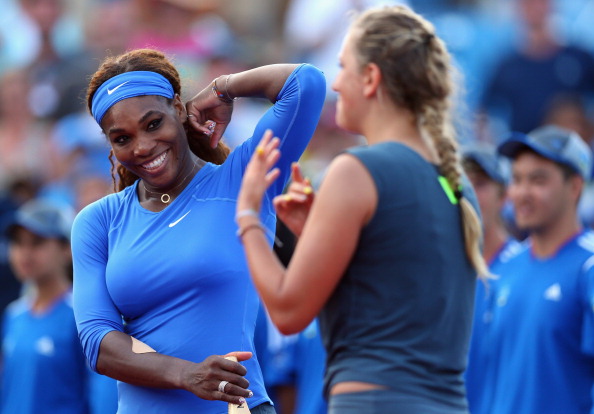
By John Huston
What a difference a few months make for the WTA’s marquee stars. Going into Wimbledon, French Open winner Serena Williams and finalist Maria Sharapova were duking it out via interviews and press conferences. What’s happened since then? Well, Marion Bartoli won Wimbledon—and promptly retired. Serena claimed her first small-fry International-level title (!) on clay in Sweden (!), shifted her winning form somewhat uneasily to North American hard courts, and steered graciously and gracefully clear of mouthy mistakes while wearing form-fitting leather on David Letterman. As for Sharapova, where do we begin? She hired Jimmy Connors as coach and then fired him after a single match, a loss to rising star and drama-magnet Sloane Stephens. (Afterward, Connors tweeted that it was time for him to enjoy a “vodka on the rocks.”) Next came a candy-peddling PR stunt about renaming herself Maria Sugarpova for the US Open. But a day later, Sugarpova morphed into Shoulderpova, with news that she’d withdrawn from the tournament, and the worrisome possibility that a chronic injury has flared up again. Clearly, it’s time for some reassessment in the Sharapova camp.
What does that mean for the women’s draw at the US Open? Nothing changes up top: US Open Series winner Serena is still number one, and the relative favorite, though Victoria Azarenka defeated her in the final of the last warmup tournament in Cincinnati. In the first round, Serena faces a fellow Slam champ, and a player who has troubled her in the past, Francesca Schiavone. But Schiavone’s best days are behind her. Assuming Serena plays well, she’ll avoid drama until at least the fourth round, or “All About Eve II”: a potential explosive rematch with frenemy and Australian Open nemesis Sloane Stephens. This showdown is far from guaranteed, as Stephens will likely have to beat Urszula Radwanska (who took her down this spring in Indian Wells) and Jamie Hampton to get there. On the lower half of the first quarter, Serena’s sister Venus—struggling for victories these days—has an unfortunate draw; in the first round, she’s up against 12th seed Kirsten Flipkens, who just scored a win over her in Canada. One player to keep an eye on might be young Canadian Eugenie Bouchard, who is starting to show signs of ascendancy this summer.
Agnieszka Radwanska and the unpredictable Na Li headline the second quarter. Radwanska’s summer hard court form hasn’t been stellar, but it has been solid, and her draw looks kind. Li, on the other hand, has always been a loose cannon, and her half of the quarter contains more dangerous players, including potential third-round opponent Laura Robson, who took her down in New York last year. A single quadrant contains four noteworthy players: a somewhat resurgent Jelena Jankovic faces off against big-hitting American hopeful Madison Keys in one first-round match, with the winner facing either promising Puerto Rican player Monica Puig or the powerful Russian Alisa Kleybanova, whose comeback from life-threatening cancer might be this year’s most inspiring story. A few other names to consider: Anastasia Pavlyuchenkova (a threat if she had a serve), Sabine Lisicki (once again struggling to carry her grass form over to hard courts), and Toronto finalist Sorana Cirstea, finally delivering on her promise under the coaching of Darren Cahill.
I have two words for the third a quarter: a mess. With Sharapova dropping out, Sara Errani is now the tournament’s fourth seed. Serena’s absolute drubbing of Errani in the French Open semis exemplifies the severe drop between the WTA’s ultra-elite and its ordinary top 10 faces. That said, Errani did reach the semis here last year (where Serena also trounced her), and believe it or not, she can occasionally hit through opponents on hard courts—I saw her do just that against Marion Bartoli in Indian Wells this spring. Her form at the moment isn’t good, though, so this is a big opportunity for the other players in this quarter. Unfortunately, they are by and large an unimposing bunch. The best of them: Errani’s doubles cohort Roberta Vinci; Caroline Wozniacki, who seems to be hitting stride again; and most of all Simona Halep, who is delivering some things the WTA desperately needs—thoughtful point construction, and consistent winning play from one tournament to the next. The only player besides Serena to have four titles to her name this year, Halep may be the player to watch at this tournament. Also of note: Stanford stars Mallory Burdette and Nicole Gibbs are in this quarter, facing a pair of struggling veterans, 2004 champ Svetlana Kuznetsova and Flavia Pennetta.
The fourth and final quarter seemingly belongs to Victoria Azarenka. After the Australian Open, Vika has struggled, but the recent win over Serena can only boost her confidence, and her draw here is far from intimidating. Unless she runs into a dangerously hot qualifier, she’s unlikely to face a challenge until at least the fourth round (which could bring Dominika Cibulkova or underachieving Ana Ivanovic). Her potential quarterfinal opponents are a little more challenging. She could run up against 2011 champ Sam Stosur, who just defeated her in San Diego, but Stosur is going into the tournament without her longtime coach. Or she could face onetime nemesis Petra Kvitova. The wildly streaky Kvitova seems to be playing herself into form, and she’s fitter than she has been in a while, but 2011—back when she reliably made the Wall of Vika crumble—is looking further and further away. On the face of it, this year’s US Open certainly shapes up like a potential repeat of the Serena and Vika show. And who knows, one day gruff (but heart-strong) New York may prove to be brusque (but emotional) Vika’s kind of town.


















